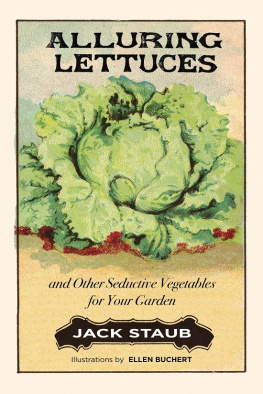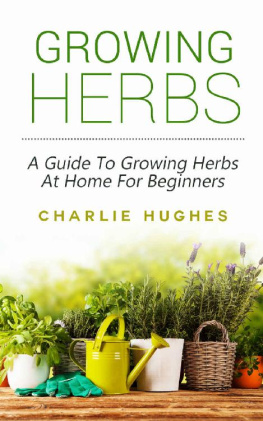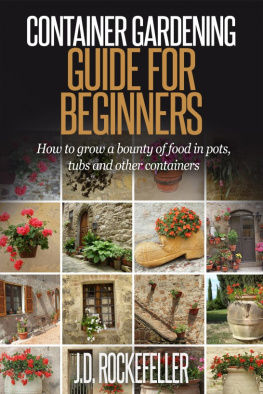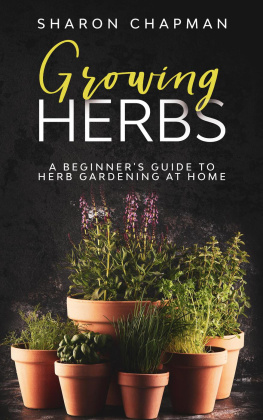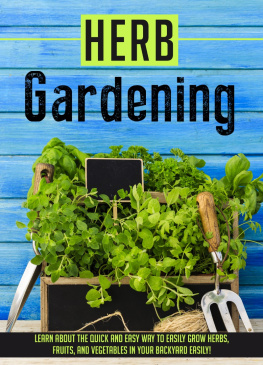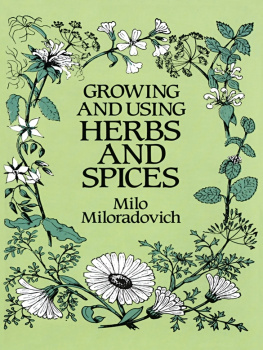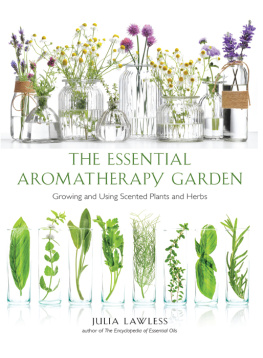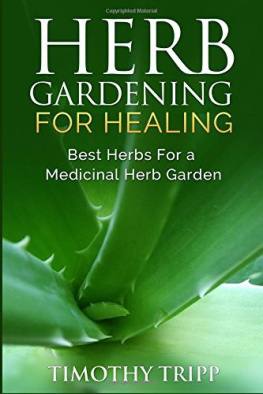Jack Staub - 75 Exceptional Herbs for Your Garden
Here you can read online Jack Staub - 75 Exceptional Herbs for Your Garden full text of the book (entire story) in english for free. Download pdf and epub, get meaning, cover and reviews about this ebook. year: 2009, publisher: Gibbs Smith, genre: Home and family. Description of the work, (preface) as well as reviews are available. Best literature library LitArk.com created for fans of good reading and offers a wide selection of genres:
Romance novel
Science fiction
Adventure
Detective
Science
History
Home and family
Prose
Art
Politics
Computer
Non-fiction
Religion
Business
Children
Humor
Choose a favorite category and find really read worthwhile books. Enjoy immersion in the world of imagination, feel the emotions of the characters or learn something new for yourself, make an fascinating discovery.
- Book:75 Exceptional Herbs for Your Garden
- Author:
- Publisher:Gibbs Smith
- Genre:
- Year:2009
- Rating:3 / 5
- Favourites:Add to favourites
- Your mark:
- 60
- 1
- 2
- 3
- 4
- 5
75 Exceptional Herbs for Your Garden: summary, description and annotation
We offer to read an annotation, description, summary or preface (depends on what the author of the book "75 Exceptional Herbs for Your Garden" wrote himself). If you haven't found the necessary information about the book — write in the comments, we will try to find it.
Gardening expert Jack Staub continues his stimulating series on unique additions to your garden with 75 Exceptional Herbs for Your Garden.
Jack Staub: author's other books
Who wrote 75 Exceptional Herbs for Your Garden? Find out the surname, the name of the author of the book and a list of all author's works by series.
75 Exceptional Herbs for Your Garden — read online for free the complete book (whole text) full work
Below is the text of the book, divided by pages. System saving the place of the last page read, allows you to conveniently read the book "75 Exceptional Herbs for Your Garden" online for free, without having to search again every time where you left off. Put a bookmark, and you can go to the page where you finished reading at any time.
Font size:
Interval:
Bookmark:

75 Exceptional Herbs
Digital Edition v1.0
Text 2008 Jack Staub
Illustrations 2008 Ellen Sheppard Buchert
All rights reserved. No part of this book may be reproduced by any means whatsoever without written permission from the publisher, except brief portions quoted for purpose of review.
Gibbs Smith, Publisher
PO Box 667
Layton, UT 84041
Orders: 1.800.835.4993
www.gibbs-smith.com
Library of Congress Catalog-in-Publishing Data
ISBN-13:978-1-4236-0251-4
ISBN-10: 1-4236-0251-X
1. Herb gardening. 2. Herbs. 3. Herbs-Pictorial Works. I. Title. II. Title: 75 exceptional herbs for your garden.
SB351.H5S696 2008
635.7dc22
2008000721
This has been a fascinating journey for me. Although I have probably cultured at least half of the herbs I offer to you in this volume, and have surely sought the comforting warmth of chamomile or lemon balm tea on a blustery day, chewed a sprig of parsley for refreshment, and noted the dynamic nutritive value of dandelions and such, my herbal acquaintance has mainly been in a culinary vein and, therefore, my medicinal knowledge sadly lacking. As a result, the multiple historic remedial applications to which most of these herbs have been subject have been a revelation to me, even those subsequently disproved by modern medicine, but particularly those whose ancient herbal employments have managed to retain their luster in the bright light of contemporary scrutiny.
It is entirely appealing tome to imagine a world in which there were no drugstores or pill manufacturers, so that it was to natures pharmacy one was compelled to apply and, like the early herbalists, open ones eyes to experimentation, observation, and, ultimately, knowledge: pounding roots into poultices, distilling tinctures and decoctions from leaves and blossoms, brewing infusions, hanging fragrant boughs from doorways, strewing floors. Certainly there were many maladies that, in the end, would not be eased or cured by such treatments but, for all those, there were countless that could beand still can be. A second joy in the composition of this volume was the identification of plants, growing probably not a hundred yards from my doorstep, which I have haphazardly noted and ignored as weedy presences during my years amongst our native Pennsylvania flora. They were and are available for numerous herbal and culinary tasks and, finally, I have the knowledge to avail myself of them.
Although I have generally eschewed any historically lauded herbs that lack modern application entirely, as mentioned, I have included a good number whose historic employments have been contemporarily modified, simply because the history and legend surrounding them is so fascinating and they are still attractive in the garden. One thing I was surprised to learn but which, ultimately, made sense was the importance of moderation in employment: to wit, a substance that in small doses might eradicate parasites or cancer or the effects of animal venom might potentially exterminate you in larger onessuch is the case with herbal constituents as benign as our common parsley or garden fennel. Therefore, ingestion of the concentrated essential oils of any of the herbs I mention here should be monitored most carefully. Another point of interest was the incredible antioxidant potential of some of these herbs, particularly those members of the mint clan containing carvacrol, thymol, and rosmarinic acid, or those plants rich in omega-3 fatty acids, these giving stunning new import to the idea of a comforting cup of herbal tea.
Occasionally in this book, I will stop to laud a plant but advise you to seek the herb (for instance, saffron) or the rendered oil at your local market or health-food store, as, while the plant itself may be comely in the garden, the processing of its herbal product is best left to someone else. On other occasions, I will counsel you to eschew planting the herb in question, as it is probably available in near weedy ubiquity in your local wild, and to seek it out there for its beneficial herbal applications. But for most, I will urge you to both plant and employ it and, if you have the space for it, heartily endorse the construction of your own herb garden (light sandy soil, full sun) to decorate and scent your precincts, spice up your cuisine, and cure what ails you. In any event, I hope you will enjoy this journey as much as I have, and I wish you both exceeding good health and excellent dining along the way.
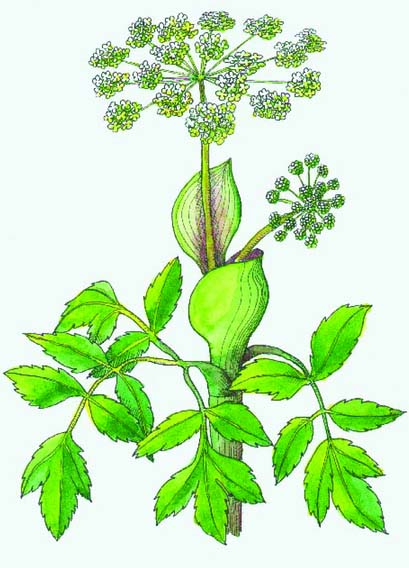
Image 1: ANGELICA
Who couldnt love an herb with the exalted sobriquet of angel of the archangel? A close, if supersized, relation to carrots, parsley, fennel, and celery in the greater Umbelliferae family, angelica, even before the dawn of Christianity, was regarded as a kind of cure-all counterbane against evil spells and enchantments. Although some botanists believe that angelica may be originally native to Syria, it has grown in frosty Iceland and Lapland since time immemorial, and an ancient Latvian ritual still involves an annual early summer procession in which Latvians bear armfuls of angelica, voicing chants so venerable that nobody knows their meaning. Angelica was thought to bloom on May 8, the feast day of St. Michael (the Archangel who delivered the glad tidings of the holy birth to the Virgin), and became closely associated with the Annunciation. A spray of angelica worn on St. Michaels Day is still thought to bestow near-universal healing and protection upon anyone who carries it.
Ultimately, angelica was held in such high religious esteem that it earned the additional appellation Root of the Holy Ghost. John Parkinson, in his Paradisi in Sole Paradisus Terrestris of 1629, among many other uses, recommends a decoction of angelica for swounings, when the spirits are overcome and faint, or tremblings and passions of the heart, and the dried, powdered root added to wine to abate the rage of lust in young persons, which must have been happy news and of significant use to medieval parents. Nicholas Culpeper, in his Complete Herbal of 1653, maintained angelica root would wonderfully help ... the bitings of mad dogs and other venemous creatures, and Christopher Sauer, Americas first herbalist, in his Herbal Cures of 1764, echoed far earlier sentiments when he noted, When the winds of death are blowing, Angelica makes an excellent prophylactic against dangerous contagion...
Font size:
Interval:
Bookmark:
Similar books «75 Exceptional Herbs for Your Garden»
Look at similar books to 75 Exceptional Herbs for Your Garden. We have selected literature similar in name and meaning in the hope of providing readers with more options to find new, interesting, not yet read works.
Discussion, reviews of the book 75 Exceptional Herbs for Your Garden and just readers' own opinions. Leave your comments, write what you think about the work, its meaning or the main characters. Specify what exactly you liked and what you didn't like, and why you think so.


